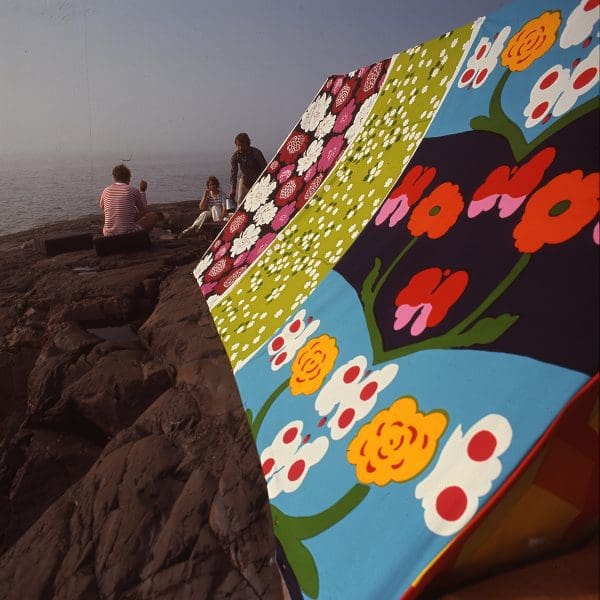
Piercing the veil
A new exhibition at Buxton Contemporary finds a rich complexity in the shadowy terrain between life and death.

Fabrics Pioni, Taivaankukat and Ibir, designed by Maija Isola in 1970, photographed in the archipelago of the gulf of Finland (foto: Arto Hallakorpi / Design Museum).

Hat and dress from the pattern Linssi (lence), pattern designed in 1966 by Kaarina Kellomäki.

Marimekko’s first fashion show was held in restaurant Kalastajatorppa, Helsinki, Finland in May 20th, 1951. The fabrics were designed by several designers like Maija isola, Eelis Muona and Eeva-Inkeri Tilhe. Garments were designed by fashion designer Riitta Immonen, who had her own fashion salon / atelée in Helsinki. She was the co-founder of the Marimekko company, but soon withdraw from it. (Photo: Kolmio).

Coat Harakka, designed by Liisa Suvanto in 1974, pattern Kottarainen designed by Katsuji Wakisaka in 1974. (Photo Seppo Saves / Designmuseum).
Curated by Helsinki Design Museum’s Harry Kivilinna, the exhibition features a broad selection of over 50 outfits, original sketches, swathes of fabric, and home-wares. Focusing on the work of Marimekko’s most influential designers, the exhibition includes examples of their designs, as well as intimate archival materials that chronicle the ethos behind the brand.
Underpinning and defining Marimekko’s history is the group of women who developed and steered the brand to success. Marimekko has captivated the public with its striking modernist fabrics and pop aesthetic, and Tansy Curtin, exhibitions manager at Bendigo Art Gallery, believes there is a need to elucidate the work of these trailblazing women.
“In many cases women have gone unrecognised or unacknowledged despite their important contributions,” she says. “There is undeniably a need to redress this.” Since its inception, Marimekko has evolved parallel to the women’s liberation movement and has struck a chord with women looking to wear forward-thinking and well designed clothing that embraces practicality and comfort over couture.
Ratia saw an opportunity to use Printex’s method of hand printing to combine cotton fabric and modern patterns. Ratia assembled a group of young and emerging artists to create designs that incorporated bold colour and large patterns, a contrast to the subdued grey hues commonly seen in the post-war period. At the suggestion of fashion designer Riitta Immonen, who became the co-founder of Marimekko, these fabrics were made into the first Marimekko collection of dresses and presented at a small fashion show at Helsinki’s chic restaurant, Kalastajatorppa on May 20, 1951. The show sold out on the night.
One of Marimekko’s early and most influential designers was Maija Isola, whose yellow and black Amfora pattern was the first Marimekko design to be printed at Printex. For over 38 years, Isola created more than 500 designs for Marimekko and many of these can be seen in the exhibition. Unikko, Isola’s graphic pattern of red poppy blooms, is synonymous with the brand and has recently been revived alongside her closely arranged polka dot pattern Kivet, the large circles reminiscent of smooth river pebbles.

Isola created many of her Marimekko designs away from the printing facilities. Photographs of her studio in the UNESCO-listed Suomenlinna, an 18th century fortress located on a group of islands close to Helsinki, are part of the archival materials on display throughout the exhibition.
A major turning point for Marimekko came in 1953 when fashion designer Vuokko Nurmesniemi was hired. Keen to design patterns and clothing that reflected the changing social and political structures of the 1950s and 60s, Nurmesniemi created her Marimekko collections with the modern woman in mind. Rather than cinched waists and pencil skirts, Nurmesniemi focused on clothing that was comfortable, unrestrictive and allowed the wearer to move easily.
Alongside their clothing range, Ratia envisioned a utopian Marimekko lifestyle that encompassed homewares, furnishings, architecture and decorative objects. In 1963 alongside Finnish architect, Aarno Ruusuvuori, Ratia ambitiously developed plans for Mari Village, a Marimekko styled community to be built close to her family home in birch forests near the coastal town of Porvoo. Eventually proving too financially restrictive, Mari Village did not progress further than Ruusuvuori’s experimental Mari House but the idea made way for the development of Marimekko’s line of ceramics and homewares. Among the most successful of these were Fujiwo Ishimoto’s decorative interior designs and in particular, his striped Ujo towel collection.
After several years of mixed success, Marimekko again came under female leadership when Amer sold the brand to advertising guru Kirsti Paakkanen in 1991. Focus was renewed and a new wave of young designers took the helm. Reflecting the times, business wear innovator Ritva Falla was hired by Paakkanen in 1997 to create Marimekko’s first collection designed specifically for the corporate environment. Recently extending further into the business and tourist market, Marimekko secured a partnership with Finland’s national airline, Finnair, and all their flights now feature Marimekko tableware and textiles combining the patterns of Maija Isola with objects designed by Sami Ruotsalainen.
Contemporary Marimekko designers have included Noora Niinikoski, Jenni Rope and 2013 Hyères Award winner, Satu Maaranen. In a nod to the early days of Marimekko, several vintage designs have been revived for a series of classic products and the brand still maintains a commanding presence in the design industry.
As Curtin concludes, “What’s so wonderful about Marimekko is that although the company’s roots are firmly in modernism, there is a timeless-ness to its designs. Ultimately, this exhibition looks at the contributions and social impact of female designers in what was a heavily male-dominated world, and how, in their different ways, they changed the lives of women across the globe through fashion and design.”
Marimekko: Design icon 1951–2018
Bendigo Art Gallery
3 March – 11 June